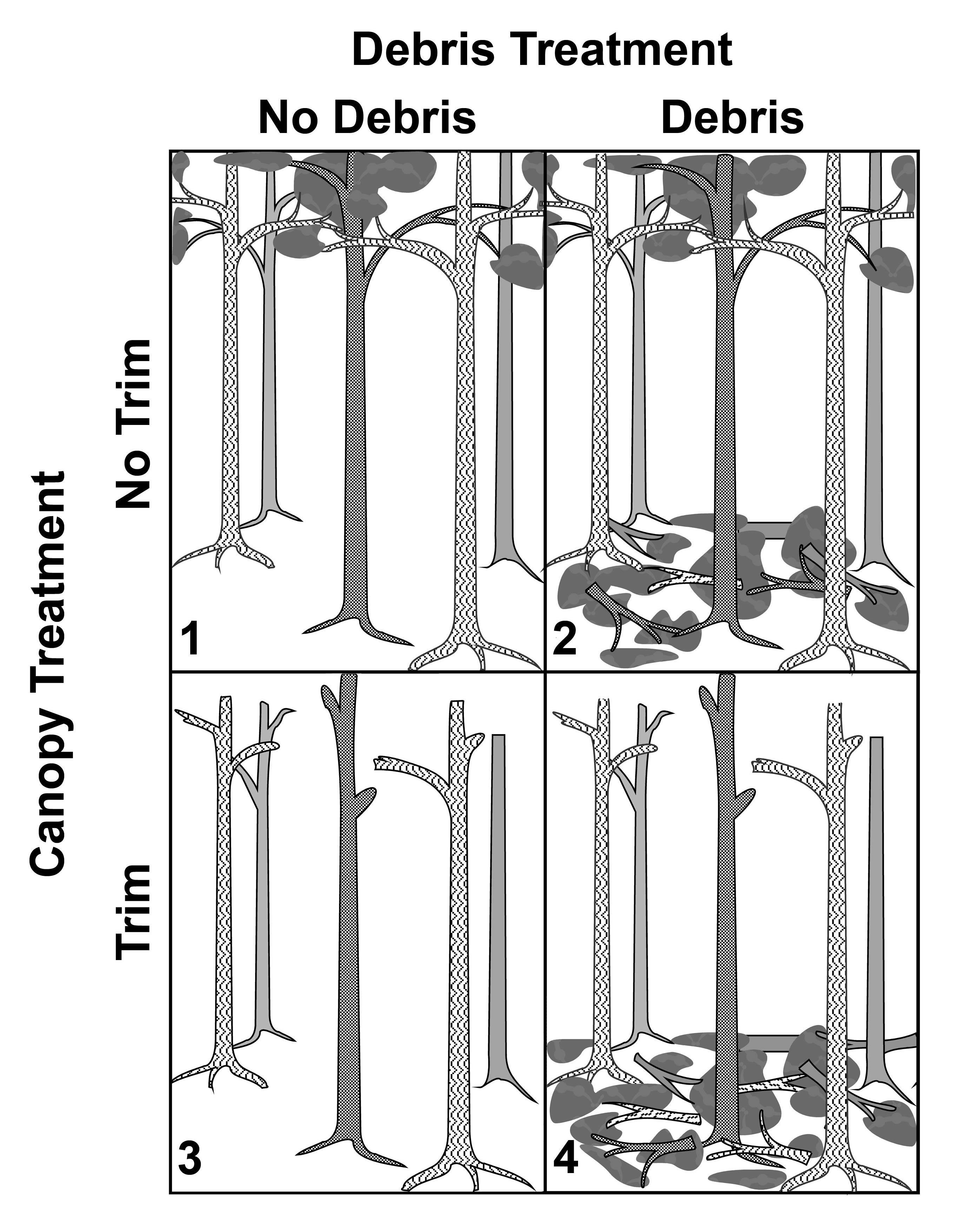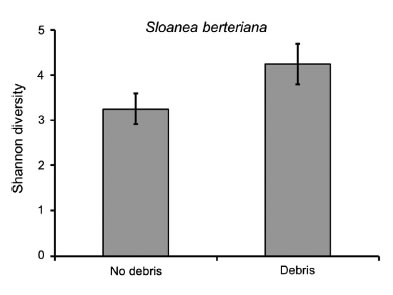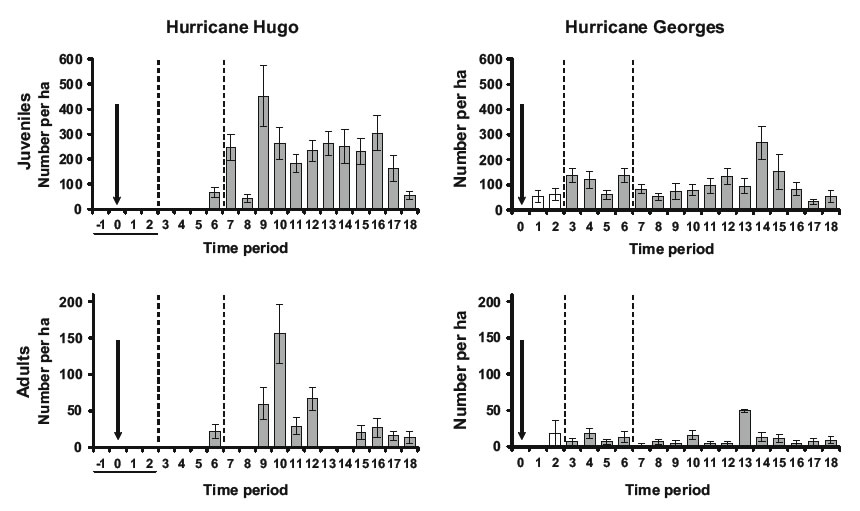Ecology of Natural Disturbances
The role of disturbance in molding the structure and function of biological systems is a major paradigm in ecology. Indeed, as the human population continues to grow, with attendant expansion of agricultural and industrial enterprises, the future of ecology may reside in understanding the ways in which disturbance modifies the structure of communities, as well as the way component species affect energy flow and nutrient cycling of disturbed ecosystems (Willig and Walker, 1999; Walker and Willig, 1999). Much of our research in the Luquillo Mountains LTER Program in Puerto Rico focuses on the response of the biota to various elements of the disturbance regime. We have documented the ways in which populations and communities of vertebrates and invertebrates respond to infrequent, but large-scale and high-intensity disturbances such as hurricanes (Gannon and Willig, 1994; Gannon and Willig, 1999; Willig and Gannon, 1996; Willig et al., 1999; Garrison and Willig, 1996; Secrest et al., 1996), as well as to frequent, but small-scale and low-intensity disturbances such as tree falls (Alvarez and Willig, 1993). Nonetheless, the legacy of human disturbance may remain for decades, and modify the responses to subsequent natural disturbances (Secrest et al., 1996; Willig et al., 1996). A conceptual model was developed for disturbance that includes subsequent trajectories of recovery by the biota (Willig and Walker, 1999). Synthetic understanding of the effects of disturbance resulted in three products. The first is a Special Feature of Biotropica that was co-edited by four LTER scientists (Zimmerman et al., 1996). The second is a series of papers in The Ecology of Disturbed Ground (part of the Elsevier Ecosystem Series) on disturbance in general (Walker and Willig, 1999; Willig and Walker, 1999), as well as on the response of animals to disturbance and their role as agents of disturbance (Willig and McGinley, 1999). The third is a synthesis volume for the Luquillo Mountains LTER site that was co-edited by a number of scientists from Puerto Rico, including Dr. Willig (Brokaw et al. 2012). Canopy Trimming Experiment
Tropical forests in the Greater Caribbean Basin are hurricane mediated, as much of the spatiotemporal variation in the structure, physiognomy, and composition of these ecosystems arises as a consequence of these intense storms. The ecological impact of these relatively infrequent but intense and large-scale disturbances has been well documented for many taxonomic groups, including plants, microbes, gastropods, insects, and bats. However, the mechanistic bases of observed responses to hurricane-induced disturbance are poorly understood. Severe hurricanes create gaps in the forest canopy, relocating the leaves and branches to the soil surface. Several associated physical changes occur as a consequence of this canopy disturbance: increased light levels at or near the soil surface, a corresponding increases in temperature and evaporation from litter and soils. In addition, the deposition of debris from the canopy represents a significant alteration to the structure of the understory as well as a major change in the quantity and quality of carbon-inputs into detrital food webs. Observational studies cannot disentangle the various mechanistic bases of changes to the environment that arise from hurricane disturbance. At the Luquillo Experimental Forest, a NSF Long Term Ecological Research site, a canopy trimming experiment (CTE) was designed to isolate the effects of canopy loss and debris deposition on plants, animals, and ecosystem processes. Large blocks of tabonuco forest were experimentally manipulated using a replicated factorial design, with treatments representing: undisturbed forest, debris deposition only, canopy loss only, and both canopy loss and debris deposition. This allowed for the simultaneous evaluation of the responses of many taxonomic groups and ecosystem processes, including phosphorous movment in leaf litter, soil chemistry, nutrient dynamics, herbivory, forest floor microbial communities, fungi, ferns, trees, terrestrial gastropods, canopy arthropods, and frogs (upcoming special issue in Forest Ecology and Management).
The responses of terrestrial gastropods to the CTE were complex, with abundances of some species responding to canopy trimming, abundances of some species responding to debris deposition, and abundances of other species responding to no treatments (Willig et al. 2014). Gastropod diversity responded to both debris deposition and canopy trimming. Temporal variation in species composition was considerable for each of the treatment combinations, with temporal trajectories for each treatment being unrelated to those of other treatments. Manipulated treatments were surrounded by large areas of intact forest, and tabonuco forest generally exhibits appreciable spatial and temporal variation. The natural spatiotemporal variation in the study system likely overwhelmed many of the effects of experimental manipulations on gastropod populations or communities via edge effects and recruitment of individuals from nearby less disturbed portions of the landscape. The responses of invertebrates from trees were evaluated from 7 species of tree that represent early and late successional species as well as understory and canopy species (Schowalter et al. 2014). Abundances of 6 of 13 arthropod taxa showed significant responses to treatments as main effects or eteractions; however, no species responded to canopy trimming as a main treatment. Similarly, canopy trimming did not affect assemblage diversity, whereas debris deposition significantly increased diversity on three late successional tree species. Overall, the debris pulse had a greater effect on canopy arthropods than did canopy opening, suggesting that changes in plant condition resulting from nutrient availability associated with debris deposition have a greater effect on canopy arthropods than do the more direct and immediate changes in abiotic conditions resulting from canopy opening. Long-Term Responses to Disburbance Regimes
Understanding the effects of disturbance and secondary succession on spatio-temporal patterns in the abundance of species has been confounded by a lack of long-term demographic data, especially in response to repeated, infrequent, and high intensity disturbances, such as hurricanes. Resistance and resilience to hurricane-induced disturbance may be mediated by legacies of previous land use by humans, although such interactive effects are poorly understood. We addressed these central issues in disturbance ecology by analyzing an extensive data set, spanning the impacts of Hurricanes Hugo and Georges, on the abundance of a Neotropical walking stick, Lamponius portoricensis, in the tabonuco rainforest of Puerto Rico from 1991 to 2007 (Willig et al. 2011). Lamponius is a specialist folivore in the understory of early successional areas and light gaps in tabonuco forest (Willig et al. 1986; Willig et al. 1993; Garrison and Willig 1996). Nonetheless, many aspects of its natural history are poorly known, especially those related to demography. By synthesizing data from two proximate sites in tabonuco forest, we were able to evaluate immediate (< 12 months), short-term (12 to 36 months), and long-term (> 36 months) responses of Lamponius to hurricane-induced disturbance. Immediate effects were hurricane-specific, with Lamponius showing much less resistance to Hurricane Hugo (97% reduction in abundance) than to Hurricane Georges (21% reduction in abundance). Large reductions in the extent of forest canopy associated with Hurricane Hugo created hot, dry microclimates at the forest floor that were not conducive to survival of walking sticks. The legacy of immediate effects persisted as abundance of Lamponius remained quite low and were undetectable for years after Hugo (see Figure). Two factors likely contributed to this phenomenon. First, the high immediate mortality of walking sticks, including their eggs, that was associated with Hurricane Hugo severely reduced the capacity for recruitment of individuals. Second, the large spatial extent of the initial disturbance and associated drought diminished the likelihood that local populations of Lamponius could be rescued by immigration from nearby areas of the forest via mass or rescue effects. After 3 years, the combination of canopy regrowth and nutrient input resulted in an abundance of understory succession plants on which Lamponius specialize, resulting in fast population growth. Subsequent closure of the canopy slowed leaf production of understory plants, resulting in diminished population densities. Differences in responses between the two hurricanes can be explained by differences in the intensity and extent of the disturbances they created.
In addition to work on natural disturbances, we also conduct research on anthropogenic disturbances, including effect of reduced impact logging in Neotropical rainforests, effects of fragmentation and habitat converstion associated with small-scall subsistence agriculture in Amazonia rainforests, and effects of anthropogenic land use patterns in Costa Rican forests.
Collaborators in Disturbance Ecology Research
Related Manuscripts Willig, M. R., and G. R. Camilo. 1991. The effect of Hurricane Hugo on six invertebrate species in the Luquillo Experimental Forest of Puerto Rico. Biotropica 23:455-461. Alvarez, J., and M. R. Willig. 1993. Effects of treefall gaps on the density of land snails in the Luquillo Experimental Forest of Puerto Rico. Biotropica 25:100-110. Gannon, M. R., and M. R. Willig. 1994. The effects of Hurricane Hugo on bats of the Luquillo Experimental Forest of Puerto-Rico. Biotropica 26:320-331. Walker, L. R., W. L. Silver, M. R. Willig, and J. K. Zimmerman, editors. 1996. Special issue: Long term responses of Caribbean ecosystems to disturbance. Biotropica 28:414-614. Brokaw, N. , T. A. Crowl, A. E. Lugo, W. H. McDowell, F. N. Scatena, R. B. Waide, and M. R. Willig, editors. 2012. A Caribbean Forest Tapestry: The Multidimensional Nature of Disturbance and Response. Oxford University Press, New York, New York. Secrest, M. F., M. R. Willig, and L. L. Peppers. 1996. The legacy of disturbance on habitat associations of terrestrial snails in the Luquillo Experimental Forest, Puerto Rico. Biotropica 28:502-514. Willig, M. R., D. L. Moorhead, S. B. Cox, and J. C. Zak. 1996. Functional diversity of soil bacterial communities in the tabonuco forest: Interaction of anthropogenic and natural disturbance. Biotropica 28:471-483. Zimmerman, J. K., M. R. Willig, L. R. Walker, and W. L. Silver. 1996. Introduction: Disturbance and Caribbean ecosystems. Biotropica 28:414-423. Willig, M. R., M. F. Secrest, S. B. Cox, G. R. Camilo, J. F. Cary, J. Alvarez, and M. R. Gannon. 1998. Long-term monitoring of snails in the Luquillo Experimental Forest of Puerto Rico: Heterogeneity, scale, disturbance, and recovery. Pages 293-322 in F. Dallmeier and J. Comisky, editors. Forest Biodiversity in North, Central, and South America and the Caribbean: Research and Monitoring. The Parthenon Press, Cranforth, Lancashire, UK. Walker, L. R., and M. R. Willig. 1999. An introduction to terrestrial disturbances. Pages 1-15 in L. R. Walker, editor. Ecosystems of Disturbed Ground. Elsevier Science, Amsterdam, Netherlands. Willig, M. R., and M. A. McGinley. 1999. The response of animals to disturbance and their roles in patch generation. Pages 633-657 in L. R. Walker, editor. Ecosystems of Disturbed Ground. Elsevier Science, Amsterdam, Netherlands. Willig, M. R., and L. R. Walker. 1999. Disturbance in terrestrial ecosystems: Salient themes, synthesis, and future directions. Pages 747-767 in L. R. Walker, editor. Ecosystems of Disturbed Ground. Elsevier Science, Amsterdam, Netherlands. Bloch, C. P., and M. R. Willig. 2006. Context-dependence of long-term responses of terrestrial gastropod populations to large-scale disturbance. Journal of Tropical Ecology 22:111-122. Bloch, C. P., C. L. Higgins, and M. R. Willig. 2007. Effects of large-scale disturbance on metacommunity structure of terrestrial gastropods: Temporal trends in nestedness. Oikos 116:395-406. Willig, M. R., C. P. Bloch, N. Brokaw, C. Higgins, J. Thompson, and C. R. Zimmermann. 2007. Cross-scale responses of biodiversity to hurricane and anthropogenic disturbance in a tropical forest. Ecosystems 10:824-838. Presley, S. J., and M. R. Willig. 2008. Composition and structure of Caribbean bat (Chiroptera) assemblages: Effects of inter-island distance, area, elevation and hurricane-induced disturbance. Global Ecology and Biogeography 17:747-757. Gannon, M. R., and M. R. Willig. 2009. Island in the storm: Disturbance ecology of plant-visiting bats in the hurricane-prone island of Puerto Rico. Pages 281-301 in T. H. Fleming and P. A. Racey, editors. Island Bats: Evolution, Ecology, and Conservation. University of Chicago Press, Chicago, Illinois. Willig, M.R., S.J. Presley, C.P. Bloch, and H.H. Genoways. 2009. Macroecology of Caribbean bats: effects of area, elevation, latitude, and hurricane-induced disturbance. Pages 216-264 in Island bats: evolution, ecology, and conservation (T. Fleming, and P. Racey, Eds.). University of Chicago Press. Prates, M. O., D. K. Dey, M. R. Willig, and J. Yan. 2010. Intervention analysis of hurricane effects on snail abundance in a tropical forest using long-term spatio-temporal data. Journal of Agricultural, Biological, and Environmental Statistics 16:142-156. Willig, M.R., S.J. Presley, and C.P. Bloch. 2011. Long-term dynamics of tropical walking sticks in response to multiple large-scale and intense disturbances. Oecologia 165:357-368. Brokaw, N., J. K. Zimmerman, M. R. Willig, G. R. Camilo, A. P. Covich, T. A. Crowl, N. Fetcher, B. L. Haines, D. J. Lodge, A. E. Lugo, R. W. Myster, C. M. Pringle, J. M. Sharpe, F. N. Scatena, T. D. Schowalter, W. L. Silver, J. Thompson, D. J. Vogt, K. A. Vogt, R. B. Waide, L. R. Walker, L. L. Woolbright, J. M. Wunderle, Jr., and X. Zou. 2012. Response to disturbance. Pages 201-271 in N. Brokaw, T. A. Crowl, A. E. Lugo, W. H. McDowell, F. N. Scatena, R. B. Waide, and M. R. Willig, editors. A Caribbean Forest Tapestry: The Multidimensional Nature of Disturbance and Response. Oxford University Press, New York, New York. Lugo, A. E., F. N. Scatena, R. B. Waide, E. A. Greathouse, C. M. Pringle, M. R. Willig, K. A. Vogt, L. R. Walker, G. Gonzalez, W. H. McDowell, and J. Thompson. 2012. Management implications and applications of long-term ecological research. Pages 305-360 in N. Brokaw, T. A. Crowl, A. E. Lugo, W. H. McDowell, F. N. Scatena, R. B. Waide, and M. R. Willig, editors. A Caribbean Forest Tapestry: The Multidimensional Nature of Disturbance and Response. Oxford University Press, New York, New York. Lugo, A. E., R. B. Waide, M. R. Willig, T. A. Crowl, F. N. Scatena, J. Thompson, W. L. Silver, W. H. McDowell, and N. Brokaw. 2012. Ecological paradigms for the Tropics: Old questions and continuing challenges. Pages 3-41 in N. Brokaw, T. A. Crowl, A. E. Lugo, W. H. McDowell, F. N. Scatena, R. B. Waide, and M. R. Willig, editors. A Caribbean Forest Tapestry: The Multidimensional Nature of Disturbance and Response. Oxford University Press, New York, New York. McDowell, W. H., F. N. Scatena, R. B. Waide, N. Brokaw, G. R. Camilo, A. P. Covich, T. A. Crowl, G. Gonzalez, E. A. Greathouse, P. Klawinski, D. J. Lodge, A. E. Lugo, C. M. Pringle, B. A. Richardson, M. J. Richardson, D. A. Schafer, W. L. Silver, J. Thompson, D. J. Vogt, K. A. Vogt, , M. R. Willig, L. L. Woolbright, X. Zou, and J. K. Zimmerman. 2012. Geographic and ecological setting of the Luquillo Mountains. Pages 72-163 in N. Brokaw, T. A. Crowl, A. E. Lugo, W. H. McDowell, F. N. Scatena, R. B. Waide, and M. R. Willig, editors. A Caribbean Forest Tapestry: The Multidimensional Nature of Disturbance and Response. Oxford University Press, New York, New York. Waide, R. B., and M. R. Willig. 2012. Conceptual overview: Disturbance, gradients, and ecological response. Pages 42-71 in N. Brokaw, T. A. Crowl, A. E. Lugo, W. H. McDowell, F. N. Scatena, R. B. Waide, and M. R. Willig, editors. A Caribbean Forest Tapestry: The Multidimensional Nature of Disturbance and Response. Oxford University Press, New York, New York. Willig, M. R., C. P. Bloch, A. P. Covich, C. A. S. Hall, D. J. Lodge, A. E. Lugo, W. L. Silver, R. B. Waide, L. R. Walker, and J. K. Zimmerman. 2012. Long-term research in the Luquillo Mountains: Synthesis and foundations for the future. Pages 361-441 in N. Brokaw, T. A. Crowl, A. E. Lugo, W. H. McDowell, F. N. Scatena, R. B. Waide, and M. R. Willig, editors. A Caribbean Forest Tapestry: The Multidimensional Nature of Disturbance and Response. Oxford University Press, New York, New York. Willig, M.R., S.J. Presley, C.P. Bloch, and J. Alvarez. 2013. Population, community, and metacommunity dynamics of terrestrial gastropods in the Luquillo Mountains: a gradient perspective. In: Ecological Gradient Analyses in a Tropical Landscape, G. González, M.R. Willig, and R. B. Waide, editors. Ecological Bulletins 54:117-140. Schowalter, T.D., M.R Willig, and S.J. Presley. 2014. Canopy Arthropod Responses to Experimental Canopy Opening and Debris Deposition in a Tropical Rainforest Subject to Hurricanes. Forest Ecology and Management 332: 93-102. Willig, M.R., C.P. Bloch, and S.J. Presley. 2014. Experimental decoupling of canopy opening and debris addition on tropical gastropod populations and communities. Forest Ecology and Management 332: 103-117. Shiels, A. B., G. González, and M. R. Willig. 2014. Responses to canopy loss and debris deposition in a tropical forest ecosystem: Synthesis from an experimental manipulation simulating effects of hurricane disturbance. Forest Ecology and Management 332:124-133. Bloch, C.P., and M. Stock. 2014. Avoidance of canopy gaps by a common land snail. Carribean Naturalist 8: 1-13. Hudson, L., et al. (243 collaborators). 2014. The PREDICTS database: a global database of how local terrestrial biodiversity responds to human impacts. Ecology and Evolution doi:10.1002/ece3.1303. |
|||||||||||||||
Please contact steven.presley@uconn.edu or michael.willig@uconn.edu if you have questions, comments, or corrections. Unless otherwise indicated, figures, tables, and images that appear on this page may not be used, reproduced, copied, or posted elsewhere, for any reasons, without permission. |



